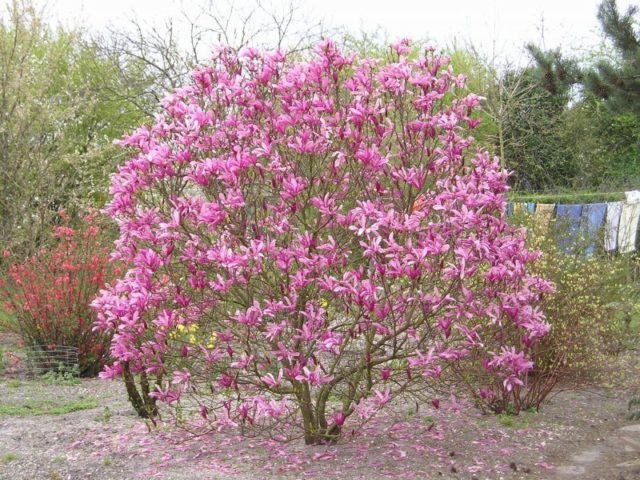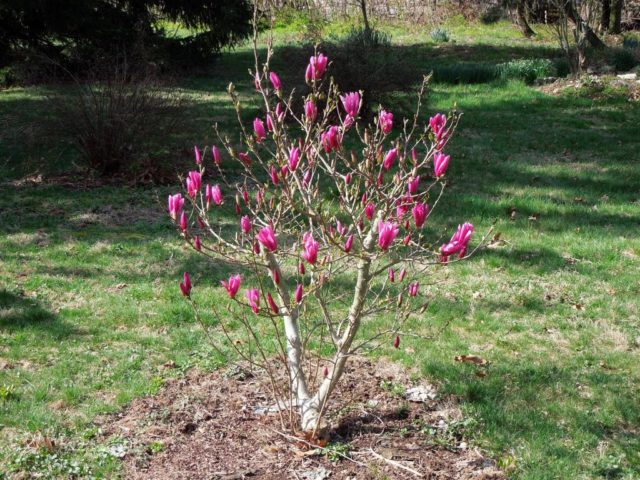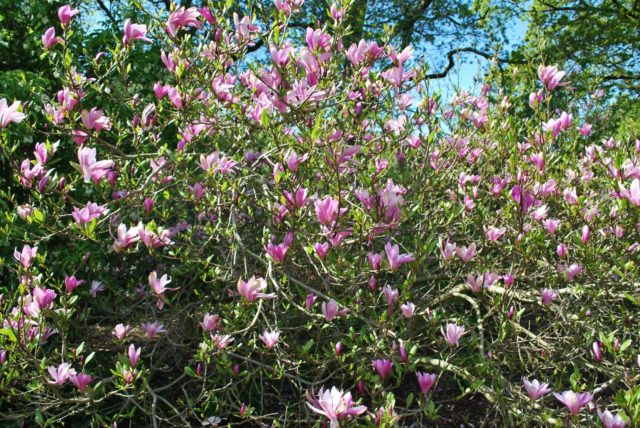Content
Magnolia Susan is a plant that can beautify any garden. However, she, like any decorative flowering tree, requires specific care. A huge disadvantage of any magnolia variety is its low winter hardiness, which causes problems when grown in regions with cold climates.
Description of the magnolia Suzanne
Suzanne magnolias are deciduous trees, reaching a minimum of 2.5 m in height, a maximum of 6.5 m. The shape of the plant is pyramidal, and the crown becomes rounder as it matures. The variety was obtained after crossing the varieties of magnolia star and lily. Susan's magnolia leaves are large, thick, rich green, glossy.
With proper care, the plant can live up to 50 years. Unfavorable conditions shorten the life of the tree.
How Susan's Hybrid Magnolia Blooms
In the description of the Susan magnolia variety, it is indicated that the flowering period of the plant falls on April and May, the complete cessation of flowering is noted at the end of June.
The flowers grow upward, have the shape of a glass, and are large. The diameter of one specimen reaches 15 cm. The flower is six-petaled, light pink, has a strong aroma.
Reproduction methods
Planting and caring for Suzanne's magnolia begins with growing a seedling. There are three breeding methods:
- cuttings;
- layering;
- seeds.
It is impossible to plant Susan's magnolia with seeds in the Moscow region, no matter how good the planting and care are. Even if the plant takes root, it will be carefully covered for the winter, the seeds will not ripen. However, in warmer climates, this is a troublesome but affordable method:
- Seeds must be planted immediately after collection, the side walls of the seed coat are too hard, so it is pierced with a needle, erased with sandpaper.
- The planting material is covered with an oily layer, which must be carefully washed off with soapy water. Then rinse with clean water.
- The seeds are planted in boxes, buried in the ground by 3 cm. The containers are removed to the basement, they are taken out only in March.
- The boxes are placed on a sunny windowsill. For 1 year, the seedling grows by 50 cm, only after that it is allowed to plant it in the ground.
At the end of June, when the magnolia fades, suitable branches are cut for grafting. There should be 3 real sheets on top. The stalk is placed in a growth activator solution, then planted in a substrate from soil and peat. The containers with Susan's magnolia cuttings are covered and placed in a room with a temperature of 19-21 ° C. After 2 months (the terms are individual), the first roots appear. After that, the cuttings are transplanted into the ground to a permanent place.
The layering method requires more time. In the spring, the lower branches are bent to the soil, buried. The branch is secured so that it does not straighten, but breaking off should also be avoided. In the fall, the cuttings will already have roots. Separating from the tree, planting future seedlings is permissible only after a few years.
Planting and caring for Susan's Magnolia
Planting Susan magnolias and maintaining the crop requires a seedling-friendly growing environment. It is especially difficult to grow a tree in the conditions of the Moscow region and central Russia.
Recommended timing
Susan's magnolia planting is delayed until October. Magnolia Susan easily tolerates a transplant during this period, since the plant enters a hibernation period. Spring planting is undesirable due to the likelihood of unexpected frosts that are detrimental to the plant.
Due to the low winter hardiness, the transplanted plant must be especially carefully covered.
Site selection and soil preparation
The soil for the best growth of Susan's magnolia should not be calcareous, sandy. Peat, black soil, compost must be added to the ground.
It is advisable to choose a light place on the site. A strong wind on a tree is undesirable. An excessively wet area is also not suitable, waterlogging is unacceptable, like drying out.
How to plant correctly
Compliance with the rules for planting magnolia will ensure good survival of the seedling, the health of an adult tree. Before starting the procedure, it is necessary to water the soil moderately. Planting Susan's hybrid is carried out as follows:
- they dig up the earth, bring in wood ash;
- make a hole 70 cm deep;
- the seedling is placed in a hole, buried;
- the soil is carefully tamped near the trunk;
- poured abundantly with warm water;
- mulch with peat.
It is forbidden to deepen the root collar; it must be located at least 2 cm above the soil surface.
Growing and caring for Susan's Magnolia
According to reviews about the cultivation of Susan's magnolia in central Russia, specific care difficulties have been identified:
- High or medium acidity of the soil is required, otherwise the plant begins to hurt.
- Freezing is recorded even with careful cover. In nitrogenous soils, the frost resistance of Susan's magnolia is reduced.
- Excess nutrients are harmful to the plant. The leaves turn yellow and dry. The solution is abundant weekly watering.
- The cause of the appearance of a spider mite can be the drying out of the soil. Therefore, timely, correct irrigation is the best prevention.
Observing the rules of watering, fertilizing, pruning, gardeners preserve the health and beauty of magnolia.
Watering
The health and decorative qualities of magnolia depend on proper watering. So that Susan's hybrid does not lose its aesthetic characteristics, they adhere to the following watering rules:
- The first 3 years after planting the seedling, watering is necessary so often that the soil is constantly wet, but not wet. Overmoistening, like dryness, destroys the young magnolia.
- A grown tree is watered up to 4 times a month. The water must be warmed up in the sun beforehand. The amount of moisture depends on the size of the plant - the older Susan's magnolia, the more it requires water.
- For better absorption of liquid, be sure to loosen the soil with a rake before watering. Since the root system is located close to the soil surface, deep loosening is prohibited.
Regardless of age, care must be taken to ensure that the soil is not excessively moist. Watering Susan's adult magnolia is only acceptable if the ground is dry.
Top dressing
If nutrients were introduced during planting, Susan's magnolia does not need fertilization for the first two years. Starting from the third year, feeding is done regularly.
For self-production of fertilizers, urea and nitrate are diluted (ratio 2: 1.5). From ready-made fertilizers, any mineral complexes developed for ornamental, flowering shrubs are suitable.
Pruning
You do not need to prune the crowns of Susan trees to form. Hygienic pruning is carried out in the fall, the tree must bloom and prepare for winter.The tools must be sharp, do not leave creases and do not damage the bark of the tree.
Places of cuts are treated with garden varnish, this is a procedure necessary for a seedling, which will avoid infection of wounds.
Pruning is prohibited in the spring. Due to the active movement of sap, any violation of the integrity of the bark harms the tree.
Preparing for winter
Magnolia hybrid Susan has low winter hardiness. Even a slight frost is contraindicated for the plant.
Therefore, when grown outdoors, careful preparation for wintering is required. The ground around the tree is mulched, covered with spruce branches, the trunk is wrapped in a warm, dense cloth.
Pests and diseases
Pests and diseases are an uncommon problem of magnolias. Among the common pests of the Susan variety:
- worms;
- spider mites;
- rodents.
Spraying the tree with acaricides will help get rid of insects. To prevent mice from reaching the trunk, roots and gnawing them, mulching is carried out in the pre-winter period. Found damage from the teeth of rodents must be treated with a solution of the drug "Fundazol".
Diseases are characterized by:
- bacterial spotting;
- gray mold;
- soot mushroom;
- powdery mildew.
Conclusion
Magnolia Susan in a warm climate will delight gardeners not only with greenery, but also with flowers. Residents of the middle lane and the north can plant a tree exclusively in winter gardens.
Magnolia Susan reviews














